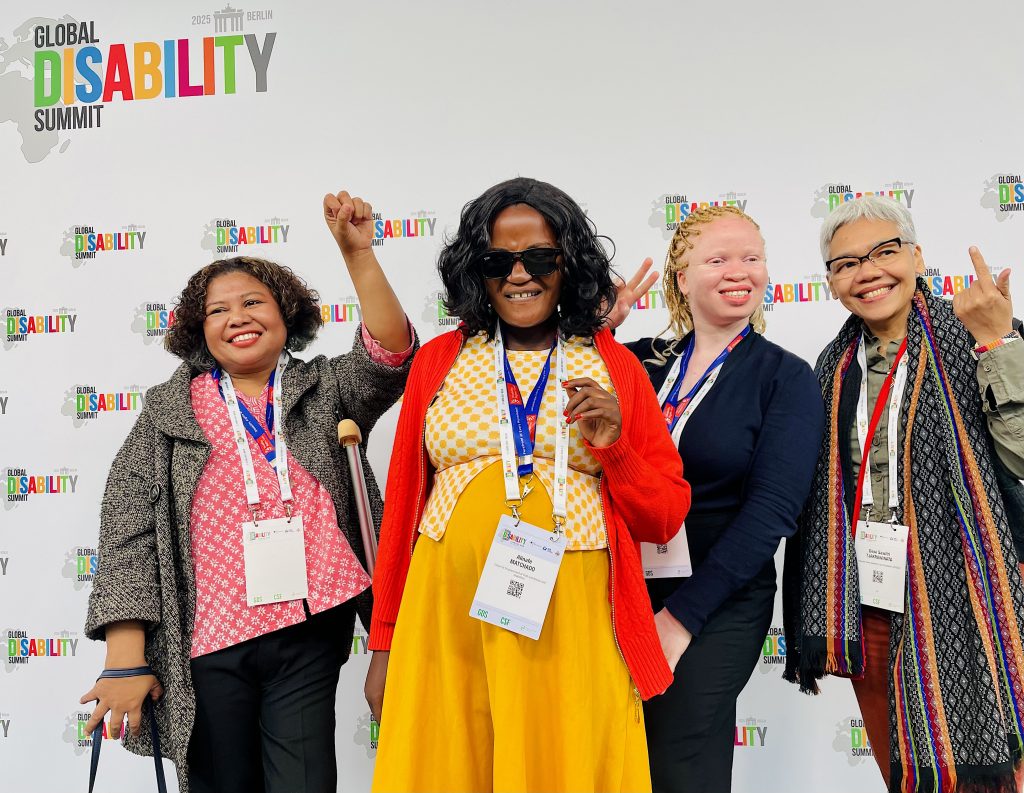The Future of Disability Justice: Collective Action, Resilient Funding, and Bold Commitments
Blog by Aapurv Jain, Associate Director of Government Partnerships at the Disability Rights Fund

A powerful delegation of women with disabilities from diverse and marginalized communities represented at GDS 2025. Photo: Rucha Chitnis
Earlier this month, I attended the 2025 Global Disability Summit (GDS) in Berlin, one of the largest global gatherings of disability rights activists, funders, and allies. It was a joy to meet so many familiar faces in person, and to share space with people advancing disability inclusion across the globe.
The Summit brought together over 4,500 participants from 110+ countries, including a vibrant representation of Global South activists and NGOs. It was a hopeful reminder that despite the magnitude of global challenges, there is powerful momentum. More than 800 commitments were made to advance disability inclusion, alongside major initiatives like the Global Disability Inclusion Report and the Partnership to Champion Disability-Inclusive Education.
As I reflect on the experience, I’ve been sitting with a few key takeaways:
The Future Is Collaborative
The most resounding message from the Summit? We move further when we move together. Amid tight funding environments, clarity and collaboration—not competition—will define our impact. The funding pot is shrinking, and in some cases, disappearing altogether. But a scarcity mindset won’t serve us. Only united can we advocate louder, grow the pie, and shift resources to where they’re most needed.
Inclusion is the Answer
At the first GDS, the former UK Secretary of State Penny Mordaunt said, “This (Disability Inclusion) is not just the right thing to do for a common humanity—it is the smart thing to do.” Over 16% of the world’s population lives with a disability, 80% of whom are in the Global South. And while the challenges abound, at DRF we also see first-hand how disability rights movements embody diversity and responsive grassroots leadership. They are creating systemic long-term solutions in the areas of education, employment, climate action and gender justice.
“Investing in disability rights is not charity—it’s justice and sustainability rolled into one.”
Aapurv Jain
Resilient Funding Models Are Non-Negotiable:
We are at a critical crossroads. Aid cuts by major donors like the US, UK, Sweden, and the Netherlands, combined with strategic shifts from longtime allies like the Open Society Foundations and Wellspring Philanthropic Fund are leaving gaping holes in disability rights funding. Essential programs are shutting down—education for children with disabilities, access to medicine and health services, humanitarian aid in refugee camps, and training for youth leaders.
We must build resilient funding models that don’t rely on a single donor or fragile DEI trends. At the Disability Rights Fund, we provide long-term funding, not just project-based grants, but also core funding, because movements need infrastructure to grow, adapt, and sustain.
The philanthropic sector needs to follow suit. Donors looking for “value for money” should invest in collaborative funds like DRF that leverage multiple resources, reaching grassroots groups in the Global South. Billionaire giving, like that from MacKenzie Scott, is welcome and needs to increase. We need long-term solidarity from the ultra-wealthy, not just short-term generosity.
Disability Inclusion Must Be Intergenerational and Intersectional
The launch of the Youth Call to Action at the Summit was a vital step. Young disabled leaders must be centered—not sidelined—in our movement’s future. With support from the German government and Robert Bosch Stiftung, DRF supported 30 activists from underrepresented communities to attend GDS and the regional pre-summits. These voices are shaping the future of disability rights, and they need continued support.
At the same time, we must break our silos and deepen intersectional work. New topics and collaborations emerged at GDS – care and support economy, climate adaptation, AI and assistive technology, inclusive education and health. Disability justice is not a niche issue. It touches everything.
From Commitments to Accountability
Since the UN Convention on the Rights of Persons with Disabilities was adopted in 2008, and the first GDS launched in 2017, we’ve made progress in shifting from a charity model to a rights-based one. But we still face massive gaps in implementation and funding. Recent data on human rights funding shows that while foundation giving increased from 2% to 4% between 2017-2020, funding from bilateral and multilateral agencies has stayed at 4%.
The 2025 Summit has set an ambitious goal: “15% for 15%”— calling for all international development programs to intentionally include persons with disabilities, who make up about 15% of the global population. It’s a powerful challenge to governments, multilateral agencies, civil society, and the private sector to walk the talk.
Let’s Keep Pushing Forward, Together
This is a moment to act boldly and in solidarity. We can’t afford to rely on unstable aid or performative DEI. Disability inclusion must be embedded in long-term strategies, policies, and budgets.
The fight for disability justice is far from over, but we’re not starting from scratch. We have momentum, movements, and vision. Let’s build on that, together!